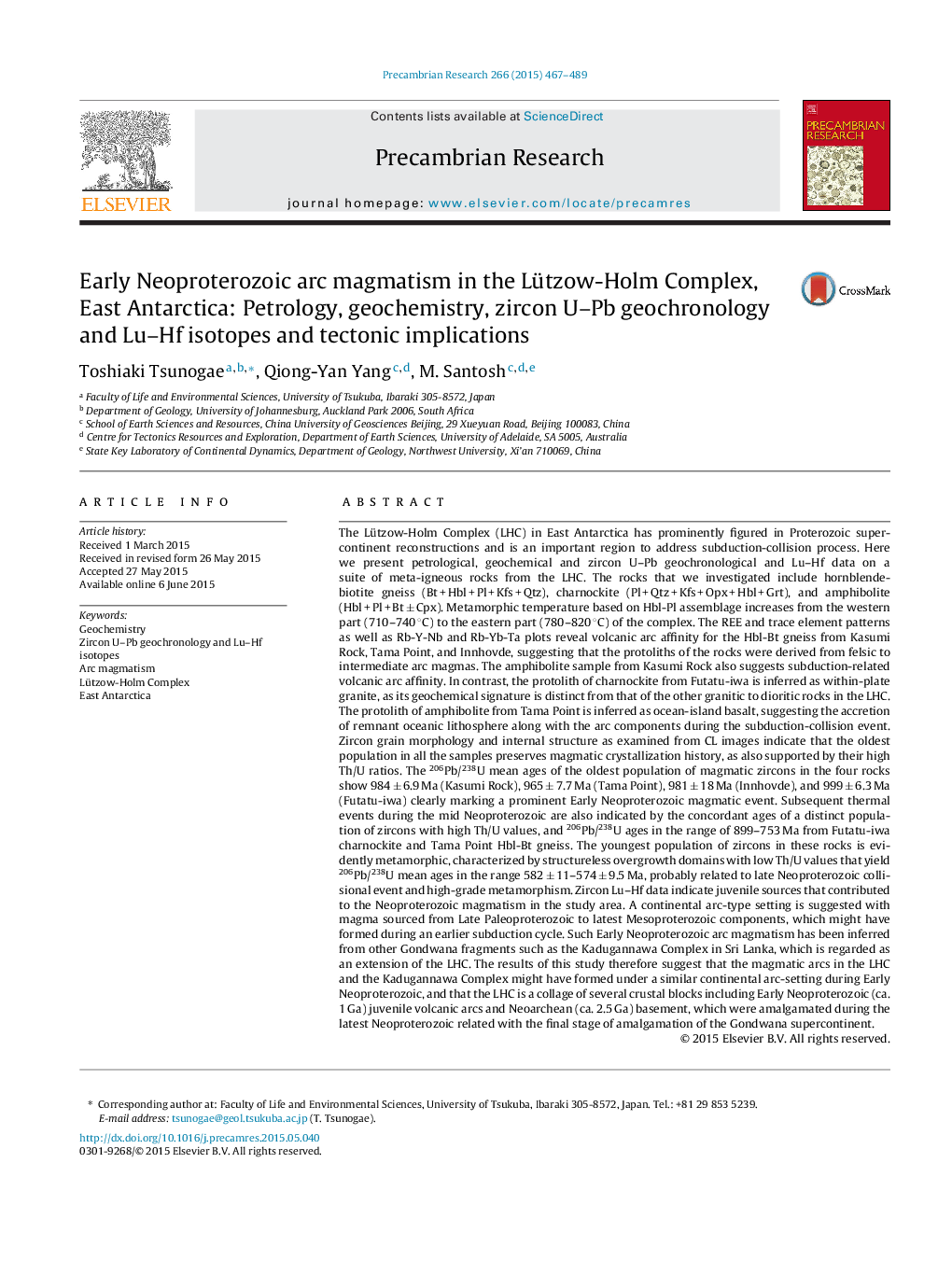| کد مقاله | کد نشریه | سال انتشار | مقاله انگلیسی | نسخه تمام متن |
|---|---|---|---|---|
| 4722554 | 1639609 | 2015 | 23 صفحه PDF | دانلود رایگان |

• Zircon U–Pb ages of 965–999 Ma suggest Early Neoproterozoic magmatism.
• Zircon Lu–Hf data suggest magma derivation from mostly juvenile components within arc setting.
• The 574–582 Ma ages from metamorphic zircons represent high-grade metamorphism related to collision.
• The ages correlate with similar events in the Sri Lankan fragment of Gondwana.
The Lützow-Holm Complex (LHC) in East Antarctica has prominently figured in Proterozoic supercontinent reconstructions and is an important region to address subduction-collision process. Here we present petrological, geochemical and zircon U–Pb geochronological and Lu–Hf data on a suite of meta-igneous rocks from the LHC. The rocks that we investigated include hornblende-biotite gneiss (Bt + Hbl + Pl + Kfs + Qtz), charnockite (Pl + Qtz + Kfs + Opx + Hbl + Grt), and amphibolite (Hbl + Pl + Bt ± Cpx). Metamorphic temperature based on Hbl-Pl assemblage increases from the western part (710–740 °C) to the eastern part (780–820 °C) of the complex. The REE and trace element patterns as well as Rb-Y-Nb and Rb-Yb-Ta plots reveal volcanic arc affinity for the Hbl-Bt gneiss from Kasumi Rock, Tama Point, and Innhovde, suggesting that the protoliths of the rocks were derived from felsic to intermediate arc magmas. The amphibolite sample from Kasumi Rock also suggests subduction-related volcanic arc affinity. In contrast, the protolith of charnockite from Futatu-iwa is inferred as within-plate granite, as its geochemical signature is distinct from that of the other granitic to dioritic rocks in the LHC. The protolith of amphibolite from Tama Point is inferred as ocean-island basalt, suggesting the accretion of remnant oceanic lithosphere along with the arc components during the subduction-collision event. Zircon grain morphology and internal structure as examined from CL images indicate that the oldest population in all the samples preserves magmatic crystallization history, as also supported by their high Th/U ratios. The 206Pb/238U mean ages of the oldest population of magmatic zircons in the four rocks show 984 ± 6.9 Ma (Kasumi Rock), 965 ± 7.7 Ma (Tama Point), 981 ± 18 Ma (Innhovde), and 999 ± 6.3 Ma (Futatu-iwa) clearly marking a prominent Early Neoproterozoic magmatic event. Subsequent thermal events during the mid Neoproterozoic are also indicated by the concordant ages of a distinct population of zircons with high Th/U values, and 206Pb/238U ages in the range of 899–753 Ma from Futatu-iwa charnockite and Tama Point Hbl-Bt gneiss. The youngest population of zircons in these rocks is evidently metamorphic, characterized by structureless overgrowth domains with low Th/U values that yield 206Pb/238U mean ages in the range 582 ± 11–574 ± 9.5 Ma, probably related to late Neoproterozoic collisional event and high-grade metamorphism. Zircon Lu–Hf data indicate juvenile sources that contributed to the Neoproterozoic magmatism in the study area. A continental arc-type setting is suggested with magma sourced from Late Paleoproterozoic to latest Mesoproterozoic components, which might have formed during an earlier subduction cycle. Such Early Neoproterozoic arc magmatism has been inferred from other Gondwana fragments such as the Kadugannawa Complex in Sri Lanka, which is regarded as an extension of the LHC. The results of this study therefore suggest that the magmatic arcs in the LHC and the Kadugannawa Complex might have formed under a similar continental arc-setting during Early Neoproterozoic, and that the LHC is a collage of several crustal blocks including Early Neoproterozoic (ca. 1 Ga) juvenile volcanic arcs and Neoarchean (ca. 2.5 Ga) basement, which were amalgamated during the latest Neoproterozoic related with the final stage of amalgamation of the Gondwana supercontinent.
Figure optionsDownload as PowerPoint slide
Journal: Precambrian Research - Volume 266, September 2015, Pages 467–489